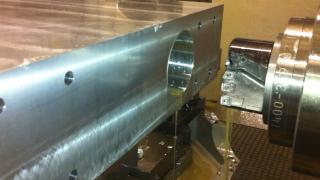
Deep Hole Drilling specialist Mollart Engineering www.mollart.com has extended its support operation for BTA drilling by creating a BTA Application Centre at its Chessington headquarters with two regionally based ‘local’ specialists based in the Midlands and north to also directly support customers in Scotland.
The application centre which is part of Mollart’s strategic future development programme under ‘Process is our Business’ is supported by tooling partner Botek. Based in Germany, Botek is a world leader in solid carbide deep hole drilling tooling and systems.
Said Mollart’s Director of Tooling Chris Barker: “Correct application support for BTA otherwise known as STS single tube system deep hole drilling process, enables users to benefit from its distinct advantage enabling a single pass to achieve hole size with higher penetration rates than with gundrilling and can be applied across a wide range of materials. It also has the advantage of providing high orders of size control, surface finish, hole straightness and bore roundness with excellent chip control and extended tool life when used with quality inserts developed for deep hole drilling.”
The BTA system can also be applied to larger diameter holes or bores where high pressure coolant is contained within the pressure head with the chips fed back through the bore of the drill tube.
The Mollart Botek BTA range of drill heads are available up to 1,000 mm diameter and includes solid drill heads, counterbore and trepanning heads.
Based at Chessington are dedicated BTA specialist engineers which are also involved in application and machine tool build process development. On-site are machines dedicated to BTA drilling and used for sub-contract production in particular, in support of customers in the oil and gas, subsea and nuclear sectors.
As a prime example, two Mollart machines recently installed in Mexico for drilling cooling holes in moulds, the application team were able to develop the process and increase existing ‘proven’ methods of hole penetration rates by 500 per cent.